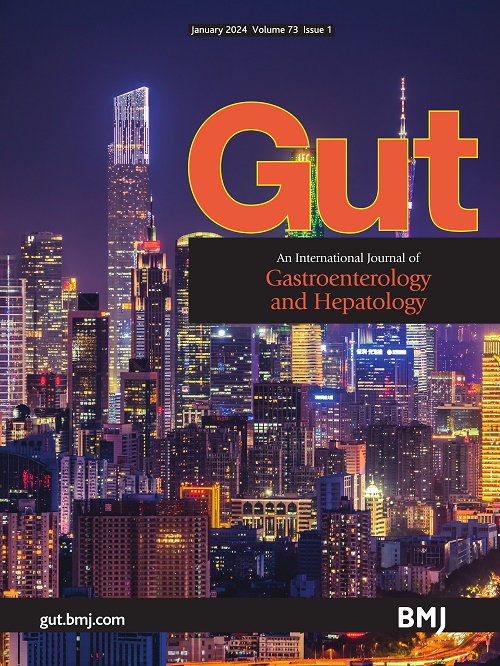双形荷叶菌增加了洗菌群移植治疗放射性肠炎。
IF 25.8
1区 医学
Q1 GASTROENTEROLOGY & HEPATOLOGY
引用次数: 0
摘要
当前基于微生物组的治疗面临两个突出问题:益生菌的有限临床疗效和不同疾病的微生物群移植疗效的显著差异。虽然水洗菌群移植(WMT)是一种新型的粪便菌群移植,但单一治疗剂不能普遍有效地治疗多种生态失调相关疾病。目的:我们提出了一种新的治疗概念,X增强WMT (X- auwmt),它将疾病特异性有益微生物“X”与WMT结合以增强其有效性。我们的目标是确定一种候选的“X”细菌来增强WMT的疗效,并检查X- auwmt在放射性肠炎(RE)动物模型中的疗效。设计:我们对一组放疗后发生RE的腹部或盆腔癌患者进行了一项前瞻性、非随机队列研究,以确定一种潜在的有益微生物。我们使用RE小鼠模型来评估X-auWMT与WMT的疗效。进行了多组学分析和实验来阐明潜在的机制。结果与常规治疗相比,swmt可显著缓解RE患者的多种临床症状。我们在RE队列中确定了双形Holdemanella biformis作为候选“X”细菌,并开发了Hb-auWMT。与WMT相比,Hb-auWMT显著减轻了辐射引起的损伤,在RE小鼠模型中表现出增强的抗凋亡作用,改善上皮缺氧的维持,增加Treg细胞水平,提高丁酸盐和戊酸盐水平。PPAR-γ是Hb-auWMT治疗效果的重要途径。结论本研究克服了上述益生菌和微生物群移植的局限性,为基于微生物群的治疗概念提供了新的研究范式。本文章由计算机程序翻译,如有差异,请以英文原文为准。
Holdemanella biformis augments washed microbiota transplantation for the treatment of radiation enteritis.
BACKGROUND
Current microbiome-based therapeutics face two prominent issues: the limited clinical efficacy of probiotics and the significant variability in the efficacy of microbiota transplantation across different diseases. Although washed microbiota transplantation (WMT) is a new faecal microbiota transplantation, a single therapeutic agent cannot be universally effective for multiple dysbiosis-related diseases.
OBJECTIVE
We introduced a new therapeutic concept, X-augmented WMT (X-auWMT), which combines a disease-specific beneficial microbe, 'X', with WMT to enhance its effectiveness. Our goal was to identify a candidate 'X' bacterium to augment WMT efficacy and examine the efficacy of X-auWMT in animal models of radiation enteritis (RE).
DESIGN
We conducted a prospective, non-randomised cohort study on a cohort of abdominal or pelvic cancer patients who developed RE after radiotherapy to identify a potential beneficial microbe. We used RE mouse models to evaluate the efficacy of X-auWMT compared with WMT. Multiomics analyses and experiments were undertaken to elucidate the underlying mechanisms.
RESULTS
WMT significantly alleviated multiple clinical symptoms in RE patients compared with routine treatments. We identified Holdemanella biformis as a candidate 'X' bacterium within the RE cohort and developed Hb-auWMT. Hb-auWMT significantly mitigated radiation-induced injury compared with WMT, exhibiting enhanced anti-apoptotic effects, improved maintenance of epithelial hypoxia, increased Treg cell levels and elevated butyrate and valerate levels in the RE mouse model. PPAR-γ is an essential pathway for the therapeutic efficacy of Hb-auWMT.
CONCLUSIONS
This study overcomes the aforementioned recognised limitations with probiotics and microbiota transplantation and provides a new research paradigm in the concept of microbiome-based therapeutics.
求助全文
通过发布文献求助,成功后即可免费获取论文全文。
去求助
来源期刊

Gut
医学-胃肠肝病学
CiteScore
45.70
自引率
2.40%
发文量
284
审稿时长
1.5 months
期刊介绍:
Gut is a renowned international journal specializing in gastroenterology and hepatology, known for its high-quality clinical research covering the alimentary tract, liver, biliary tree, and pancreas. It offers authoritative and current coverage across all aspects of gastroenterology and hepatology, featuring articles on emerging disease mechanisms and innovative diagnostic and therapeutic approaches authored by leading experts.
As the flagship journal of BMJ's gastroenterology portfolio, Gut is accompanied by two companion journals: Frontline Gastroenterology, focusing on education and practice-oriented papers, and BMJ Open Gastroenterology for open access original research.
 求助内容:
求助内容: 应助结果提醒方式:
应助结果提醒方式:


